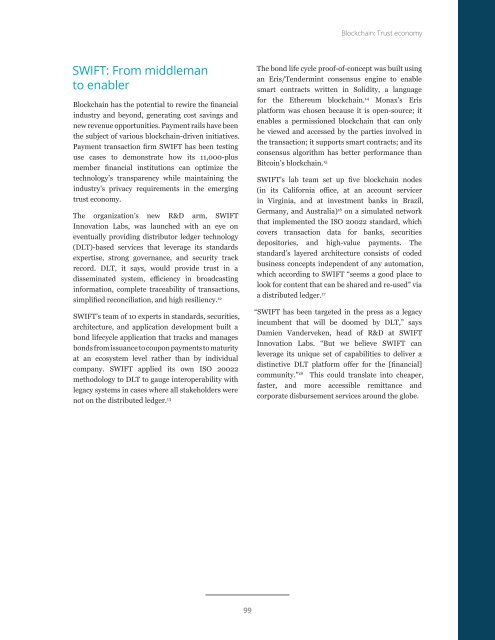Trending the trends Eight years of research
2kcf8xh
2kcf8xh
Create successful ePaper yourself
Turn your PDF publications into a flip-book with our unique Google optimized e-Paper software.
Blockchain: Trust economy<br />
SWIFT: From middleman<br />
to enabler<br />
Blockchain has <strong>the</strong> potential to rewire <strong>the</strong> financial<br />
industry and beyond, generating cost savings and<br />
new revenue opportunities. Payment rails have been<br />
<strong>the</strong> subject <strong>of</strong> various blockchain-driven initiatives.<br />
Payment transaction firm SWIFT has been testing<br />
use cases to demonstrate how its 11,000-plus<br />
member financial institutions can optimize <strong>the</strong><br />
technology’s transparency while maintaining <strong>the</strong><br />
industry’s privacy requirements in <strong>the</strong> emerging<br />
trust economy.<br />
The organization’s new R&D arm, SWIFT<br />
Innovation Labs, was launched with an eye on<br />
eventually providing distributor ledger technology<br />
(DLT)-based services that leverage its standards<br />
expertise, strong governance, and security track<br />
record. DLT, it says, would provide trust in a<br />
disseminated system, efficiency in broadcasting<br />
information, complete traceability <strong>of</strong> transactions,<br />
simplified reconciliation, and high resiliency. 12<br />
SWIFT’s team <strong>of</strong> 10 experts in standards, securities,<br />
architecture, and application development built a<br />
bond lifecycle application that tracks and manages<br />
bonds from issuance to coupon payments to maturity<br />
at an ecosystem level ra<strong>the</strong>r than by individual<br />
company. SWIFT applied its own ISO 20022<br />
methodology to DLT to gauge interoperability with<br />
legacy systems in cases where all stakeholders were<br />
not on <strong>the</strong> distributed ledger. 13<br />
The bond life cycle pro<strong>of</strong>-<strong>of</strong>-concept was built using<br />
an Eris/Tendermint consensus engine to enable<br />
smart contracts written in Solidity, a language<br />
for <strong>the</strong> E<strong>the</strong>reum blockchain. 14 Monax’s Eris<br />
platform was chosen because it is open-source; it<br />
enables a permissioned blockchain that can only<br />
be viewed and accessed by <strong>the</strong> parties involved in<br />
<strong>the</strong> transaction; it supports smart contracts; and its<br />
consensus algorithm has better performance than<br />
Bitcoin’s blockchain. 15<br />
SWIFT’s lab team set up five blockchain nodes<br />
(in its California <strong>of</strong>fice, at an account servicer<br />
in Virginia, and at investment banks in Brazil,<br />
Germany, and Australia) 16 on a simulated network<br />
that implemented <strong>the</strong> ISO 20022 standard, which<br />
covers transaction data for banks, securities<br />
depositories, and high-value payments. The<br />
standard’s layered architecture consists <strong>of</strong> coded<br />
business concepts independent <strong>of</strong> any automation,<br />
which according to SWIFT “seems a good place to<br />
look for content that can be shared and re-used” via<br />
a distributed ledger. 17<br />
“SWIFT has been targeted in <strong>the</strong> press as a legacy<br />
incumbent that will be doomed by DLT,” says<br />
Damien Vanderveken, head <strong>of</strong> R&D at SWIFT<br />
Innovation Labs. “But we believe SWIFT can<br />
leverage its unique set <strong>of</strong> capabilities to deliver a<br />
distinctive DLT platform <strong>of</strong>fer for <strong>the</strong> [financial]<br />
community.” 18 This could translate into cheaper,<br />
faster, and more accessible remittance and<br />
corporate disbursement services around <strong>the</strong> globe.<br />
99


